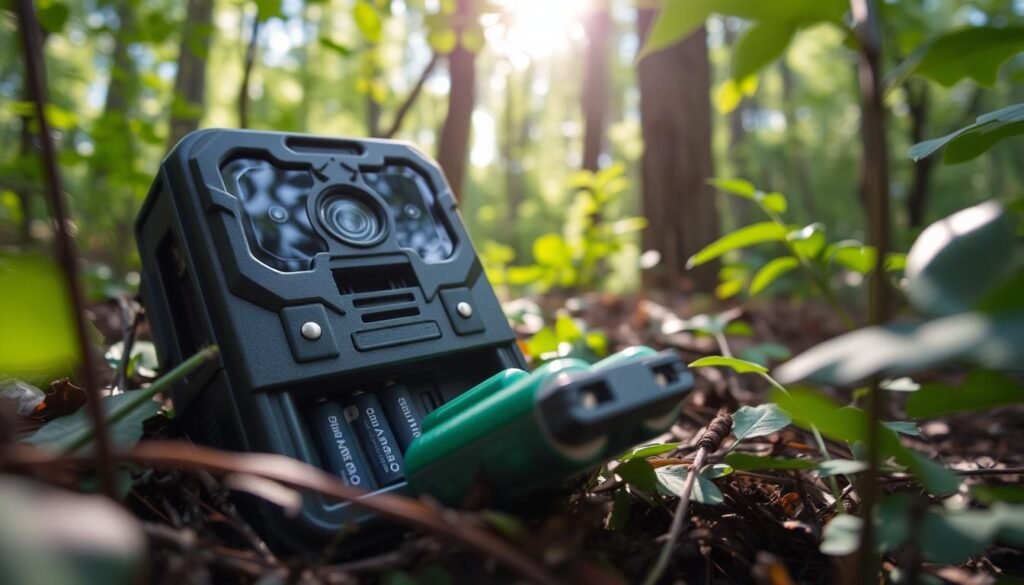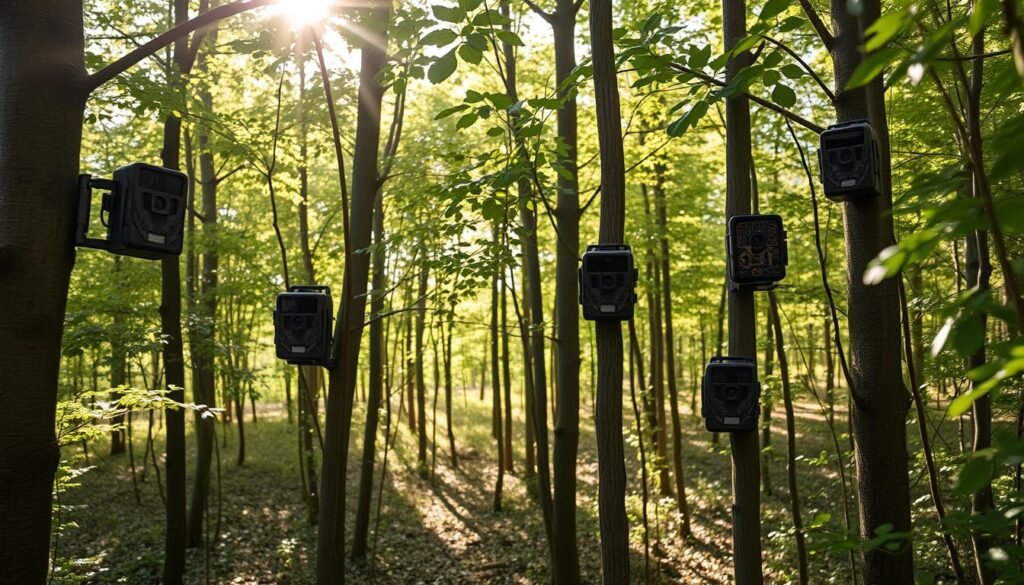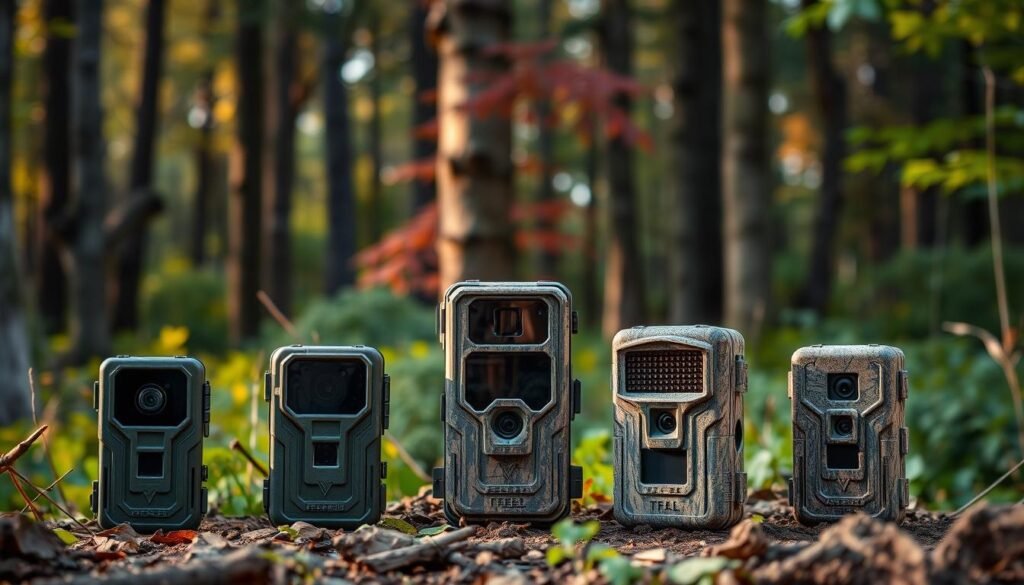Cellular trail cameras have changed outdoor scouting in the last five years. They offer real-time wildlife data and less disturbance to hunting areas. Now, you can expand your scouting range with these advanced devices.
Many cellular trail camera models are now available for under $150. This makes them more accessible to a wider range of outdoor enthusiasts.
This guide will help you find the best cellular trail cameras for 2023. We’ll look at features, performance, and value to aid your decision.
Table of Contents
ToggleKey Takeaways
- Cellular trail cameras have revolutionized outdoor scouting and monitoring, offering real-time access to wildlife data.
- Numerous affordable models are now available, making cellular trail cameras more accessible to a wider range of users.
- These cameras provide reduced disturbance to hunting areas and the ability to expand the scouting range.
- Cellular connectivity allows for remote access to images, enabling better understanding of animal behavior and movement patterns.
- With features like high-definition photos, video, and fast trigger speeds, cellular trail cameras are a game-changer for outdoor enthusiasts.
The Advantages of Cellular Trail Cameras
Cellular trail cameras offer unique benefits for hunters and wildlife enthusiasts. They provide real-time scouting, less intrusive monitoring, and cover a wider area. These features make them increasingly popular among outdoor enthusiasts.
Real-Time Scouting
Cellular trail cameras send photos and videos instantly. Hunters can access crucial scouting information right away. This helps them track animal movements and find game more effectively.
With up-to-date activity reports, hunters can make smarter choices. This increases their chances of a successful hunt.
Less Intrusive Monitoring
These cameras reduce disturbances in hunting areas. Hunters don’t need to check cameras in person often. They can monitor activity from home or on their phones.
This approach keeps wildlife behavior natural. It ensures a more authentic scouting experience.
Expanded Scouting Area
Hunters can use multiple cellular cameras across different sites. This allows them to watch a larger area without visiting each spot. They gain a better understanding of game movements in the region.
“Cellular trail cameras have revolutionized the way I approach hunting. The ability to receive real-time updates and monitor multiple locations has significantly enhanced my scouting efforts and increased my chances of success in the field.”
Cellular trail cameras are valuable for hunters and wildlife watchers. They offer efficient, non-intrusive, and thorough scouting. These cameras improve game monitoring and enhance the outdoor experience.
Understanding Image Quality in Trail Cameras
More megapixels don’t always mean better image quality in trail cameras. Many manufacturers use software to inflate megapixel ratings. Compression algorithms also affect the quality of images on your device.
To truly assess image quality, evaluate actual photos captured by the camera. This is the most reliable method for determining a trail camera’s performance.
Flash type is crucial for image quality. Trail cameras offer no glow, low glow, and red glow infrared, as well as white flash. White flash provides the best nighttime images but may disturb wildlife.
| Flash Type | Image Quality | Intrusiveness |
|---|---|---|
| No Glow Infrared | Moderate | Low |
| Low Glow Infrared | Good | Moderate |
| Red Glow Infrared | Good | Moderate |
| White Flash | Excellent | High |
New technologies like Stealth Cam Deceptor Max’s Revolver 360 feature boost image capture chances. It offers six trigger zones for improved performance.
Proper camera settings are vital for optimizing photo quality. These include resolution, detection range, burst mode, and recovery time.
Remember, examining actual photos is the best way to judge trail camera quality. Consider specific features and performance to find the right camera for your needs.
Types of Trail Camera Flashes
Trail cameras use various flash types, each with unique pros and cons. Knowing these differences helps you pick the best camera for your needs.
Red Glow Infrared
Red glow infrared cameras emit visible red light when triggered. They capture bright, clear night photos of wildlife. However, the red glow may startle some animals.
Low Glow Infrared
Low glow infrared cameras emit a faint red light. They balance range and stealth, providing good night photos. These cameras are popular among wildlife enthusiasts who want minimal environmental impact.
No Glow Infrared
No glow infrared cameras, also called “black infrared,” use filters to make the flash invisible. They’re the most discreet option, less likely to disturb animals. However, they may have a shorter flash range than other types.
| Flash Type | Visibility | Illumination | Stealth |
|---|---|---|---|
| Red Glow Infrared | Visible red glow | Bright and clear night photos | Less stealthy |
| Low Glow Infrared | Barely visible red glow | Sufficient illumination for quality night photos | More stealthy |
| No Glow Infrared | Completely invisible | Slightly shorter flash range | Most stealthy |
Choose a trail camera based on your specific wildlife monitoring or hunting needs. Consider the flash type that fits your preferences and environment best.
Maximizing Battery Life for Cellular Cams
Cellular trail cameras have transformed wildlife monitoring. Their success relies on dependable battery performance. Choosing the right batteries and power-saving methods can significantly extend your camera’s lifespan.
Battery Types and Options
Selecting the right batteries is crucial for longer-lasting cellular trail cameras. Alkaline batteries are cheap but short-lived. Lithium batteries outperform alkalines, lasting up to twice as long.
Rechargeable batteries offer a balance of cost-effectiveness and durability. They’re a smart choice for frequent users.
For cameras needing more power, 12V battery boxes are excellent. These weatherproof units keep cameras running longer, perfect for dedicated wildlife watchers.
Solar Power Packs
Solar power packs are the best solution for extending battery life. They use sunlight to keep your camera charged indefinitely.
High-quality solar packs eliminate frequent battery changes. Your camera stays in the field, capturing wildlife moments without interruption.
Optimizing your cellular trail camera’s performance is achievable. Use the right batteries and power-saving techniques. You’ll spend more time observing and documenting nature’s wonders.

Trigger Speed and Recovery Time
Trail camera trigger speed and recovery time are vital for capturing wildlife photos. These factors determine whether you’ll get the perfect shot or miss it entirely.
Top-notch trail cameras have trigger speeds of 0.5 seconds or less. The Bushnell Trophy Cam HD 2014 leads with a 0.14-second trigger speed. Its recovery time is also impressive at just 3.3 seconds.
Slower models like the Covert Code Black 3G lag behind. With a 1.38-second trigger speed and over 50-second recovery time, they often miss wildlife movements.
| Camera Model | Trigger Speed (seconds) | Recovery Time (seconds) |
|---|---|---|
| Bushnell Trophy Cam HD 2014 | 0.14 | 3.3 |
| Reconyx HC500 | 0.22 | N/A |
| Covert Code Black 3G | 1.38 | 62.6 |
| Spypoint Live | 2.70 | N/A |
| Covert MP-E5 | N/A | 36.1 |
Assessing a trail camera’s real-world performance is crucial for choosing the right one. Consider your needs, whether for hunting or capturing trail camera trigger speed, trail camera recovery time, and capturing animal movements.
best cellular trail camera
Picking the right cellular trail camera can be tricky. There are many options available. Let’s explore the top cellular trail cameras of 2023.
The Tactacam Reveal X-Pro 3.0 is the best overall choice. It costs $155 with $5 monthly plans. This camera has a quick trigger speed under 0.5 seconds.
It also has an 80-foot detection range. Its real-time image transmission and easy-to-use app make it popular among hunters.
The SpyPoint Flex G-36 offers the best value at $100. It has a 0.3-second trigger speed and 100-foot detection range. This camera is great for budget-conscious buyers.
| Camera Model | Best For | Price | Trigger Speed | Detection Range |
|---|---|---|---|---|
| Tactacam Reveal X-Pro 3.0 | Best Overall | $155 | Under 0.5 seconds | 80 feet |
| SpyPoint Flex G-36 | Best Value | $100 | 0.3 seconds | 100 feet |
| Stealth Cam Deceptor Max | Best Nighttime Photos | $120 | N/A | 80 feet |
The Stealth Cam Deceptor Max excels at nighttime photography. It costs $120 with $5 monthly plans. Its no-glow flash allows for discreet wildlife monitoring.
The Deceptor Max has an 80-foot detection range. It’s perfect for capturing high-quality nighttime images without disturbing animals.
Choose your cellular trail camera based on your needs. Consider your budget, hunting area, and personal preferences. These top-rated cameras offer real-time, remote wildlife monitoring in 2023.
Evaluating Cellular Camera Apps
Cellular trail camera apps boost user experience alongside impressive hardware. They offer intuitive photo organization and efficient sorting tools. These features streamline the management of scouting data.
Photo Organization
Apps provide robust photo organization features for easy sorting and filtering. Look for advanced options like sorting by date, location, or animal type. These tools make finding specific photos quick and simple.
Cost of Data Plans
The cost of cellular data plans is crucial when evaluating apps. Long-term operating costs can vary significantly between manufacturers. Research and compare available plans to find the most cost-effective solution for your needs.
| Cellular Trail Camera App | Photo Organization Features | Data Plan Costs |
|---|---|---|
| Tactacam Reveal App |
|
|
| Spypoint Link-S App |
|
|
Careful evaluation of photo organization features ensures effective scouting. Considering data plan costs helps create a seamless digital ecosystem. Together, these factors support your trail camera setup for optimal performance.
Top Picks for 2023
Several cellular trail cameras excel in performance, image quality, and user-friendly features. This guide highlights the top picks for 2023. Find the ideal camera for your specific needs.
Best Overall: Bushnell Core DS-4K No Glow
The Bushnell Core DS-4K No Glow ranks as the best overall cellular trail camera. It scores 75 overall, with impressive trigger speed and detection range. Its well-rounded capabilities suit various hunting and wildlife monitoring needs.
Best Value: Spypoint Force-20
The Spypoint Force-20 offers the best value for budget-conscious buyers. It scores 71 overall and excels in nighttime detection. With a 100-foot range day and night, it delivers impressive performance at an affordable price.
Best Night Photos: Spypoint Force-Pro
The Spypoint Force-Pro leads in capturing stunning nighttime wildlife images. It features 30MP stills and 4K video with audio. The camera boasts exceptional low-light performance with a 100-foot detection range.
While lacking wireless connectivity, its image quality and versatility make it a top choice. The Force-Pro excels for those prioritizing nighttime performance in cellular trail cameras.

Conclusion
Cellular trail cameras have changed how hunters and nature lovers scout wildlife. They offer real-time data access and less disturbance to hunting areas. These devices are now crucial for many outdoor enthusiasts.
The market provides various options for different budgets and needs. Some cameras have water-resistant designs with IP65 or higher ratings. Data plans can cost $5 to $10 per 1,000 photos.
Browning, Spypoint, and Stealth Cam offer free first-month data plans. This allows users to try the technology before committing to a subscription.
New features include 2K video quality and non-emitting infrared LEDs for night use. Extended battery life ensures users can capture high-quality wildlife footage with minimal disturbance.
Cloud storage and mobile app connectivity enable remote monitoring and real-time alerts. These features make cellular trail cameras valuable for wildlife fans and security-minded individuals.
FAQ
What are the key advantages of cellular trail cameras?
Cellular trail cameras offer real-time scouting info access. They reduce disturbance to hunting areas. These cameras also help expand your scouting range.
How do megapixels and image compression affect the quality of trail camera photos?
More megapixels don’t always mean better image quality. Many trail cameras use software to inflate megapixel ratings. Compression algorithms vary between manufacturers, impacting image quality on your device.
What are the different types of trail camera flashes and their pros and cons?
Red glow infrared cameras emit visible light for clear night photos. They may spook some animals. Low glow infrared cameras emit barely visible light, balancing range and stealth.
No glow infrared cameras use filters to make the flash invisible. They’re the most discreet but may have limited range.
How can I maximize the battery life of my cellular trail camera?
Consider using alkaline, lithium, or rechargeable batteries. A high-quality solar power pack can keep the camera running indefinitely in many cases.
What is the importance of trigger speed and recovery time in trail cameras?
Trigger speed affects how quickly a camera captures an image. Recovery time is how fast it resets for the next shot. These factors are crucial for high-quality wildlife photos.
What features should I look for in a cellular trail camera app?
Look for intuitive photo organization and efficient sorting tools. User-friendliness is key. Consider the cost and structure of cellular data plans offered by manufacturers.

